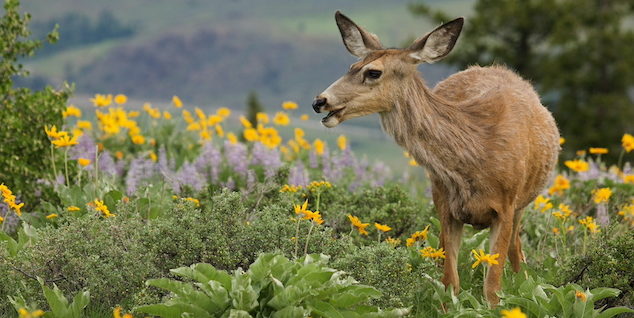Opinion
When It comes to wildlife crossings, California must catch up
 A mule deer with sunflowera in a mountain meadow. (Photo: Tom Reichner, via Shutterstock)
A mule deer with sunflowera in a mountain meadow. (Photo: Tom Reichner, via Shutterstock)It’s true that California leads the nation in many progressive policies, but when it comes to funding and implementing wildlife crossings to preserve biodiversity, the Golden State is a step behind.
Roads and development create massive barriers for wildlife. Mountain lions, desert tortoises, California tiger salamanders and many other creatures have watched their home turf shrink. Building or upgrading wildlife crossings and preserving existing habitat can go a long way toward saving the state’s most imperiled species.
With legislators back in Sacramento after a summer recess, they should seriously consider protecting the rich biodiversity that is under constant threat from encroaching development.
If California’s public leaders want to do better, all they need to do is look around at other states.
In Washington, scientists have seen toads, salamanders and pikas using new underpasses and culvert improvements made on the I-90 Snoqualmie Pass. Footage from an overpass this summer showed a herd of elk safely crossing the same freeway. In Wyoming, crossings for Highway 191 have helped pronghorn and other large mammals.
With legislators back in Sacramento after a summer recess, they should seriously consider protecting the rich biodiversity that is under constant threat from encroaching development and a warming climate. The extinction crisis is here, but there are tangible steps we can take to change course.
Crossings in the form of overpasses, underpasses and culvert upgrades protect not just wildlife but people, too. There were more than 25,000 reported vehicle collisions with large mammals like deer between 2015 to 2018, according to the UC Davis Road Ecology Center. These accidents resulted in the loss of human lives, injuries and property damages estimated at more than $1 billion.
This is why lawmakers, regardless of their political leanings or environmental record, should prioritize wildlife connectivity on their legislative agendas. Road safety cannot be ignored as wildlife habitat shrinks across the state.
California already has a road map for next steps. Success stories abound in areas with wildlife crossing infrastructure. Utah saw a 98.5% reduction and Colorado saw an 89% reduction in wildlife-vehicle strikes on stretches of highways with crossings.
The California Department of Fish and Wildlife published a report that identifies priority wildlife movement barrier locations throughout the state. Earlier this year Caltrans published a best practices guide on road safety for amphibians and reptiles.
These types of studies are important if transportation agencies want to maintain a road and highway system that doesn’t further harm sensitive species. The state also needs to collect comprehensive roadkill data, which can help identify prime locations for new or improved crossings.
Existing crossings in California are evidence that more are needed to stem the extinction crisis and improve road safety. In Orange County, underpasses and directional fencing on a toll road are helping drivers avoid collisions with pumas, bobcats, coyotes and deer. In the Sierra National Forest, an elevated section of a road allows toads, snakes and rodents to safely cross.
As roads and highways are built and improved, wildlife connectivity must be integrated into their designs early in the planning process. While retrofitting roadways to include wildlife crossings is important, it can be difficult and more expensive.
California can become a leader if it embraces a proactive approach to building wildlife crossings. We want to say with confidence that as California goes, so goes the nation. It’s time to make wildlife connectivity a top priority.
—
Editor’s Note: Tiffany Yap, PhD, is a senior scientist and wildlife connectivity advocate at the Center for Biological Diversity.
Want to see more stories like this? Sign up for The Roundup, the free daily newsletter about California politics from the editors of Capitol Weekly. Stay up to date on the news you need to know.
Sign up below, then look for a confirmation email in your inbox.

Leave a Reply